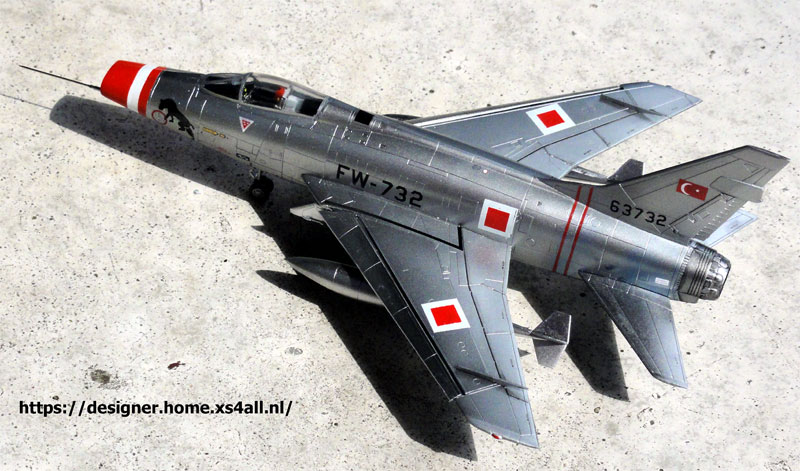[ page 4 ]
1/72 scale kits of the North American F-100D Super Sabre, made by Meindert de Vreeze
... continued from page 3
Another ESCI kit of the F-100D was made, now to be finished in a scheme of the F-100D of the Turkish Air Force "Türk Hava Kuvvetleri" of the early seventies with old style national markings (prior 1972).
The kit was made in a similar fashing as the first kit described on page 1.... So, intake was opened up, exhaust deepened.
The canopy was
to be installed closed.
NOTE: if you want an open up canopy:
inside the canopy the round bulge moves along with the canopy as it is
installed inside. The kit bulge is moulded fixed onto the fuselage halves
(indicated to be painted "A" back by ESCI in kit instructions STEP 2).
So you need than to cut away the bulge at each halve. Make a new bulge
for inside the canopy rear.
The kit has the slats moulded within the wing leading edges. As always parked F-100 aircraft have their slats drooped down, this kit would get drooped slats to be shown. The slats in the kits'wing were carefully sawed off with a razor saw on both wing halves parts #12A, 13A with a wie chord as indicated by the panelline and a tiny thin chord section of the lower wing #11B. These are needed later so be carefull here. The lower and upper slat parts were glued together to get the loose separate slat.
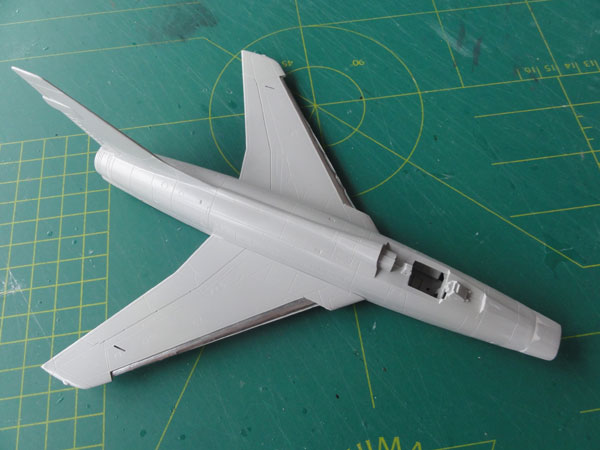 .
.
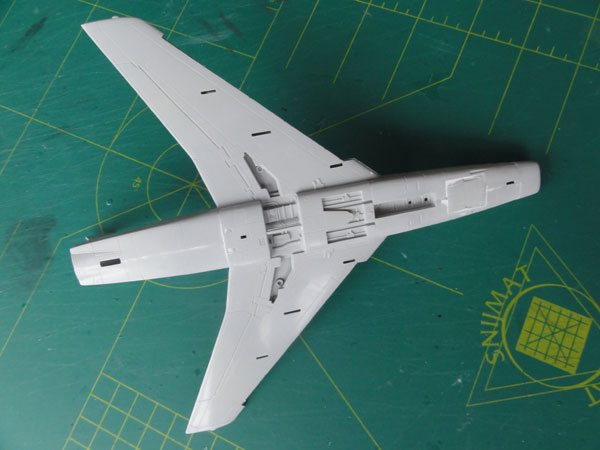
The wing "gap" was closed with thin
metallic foil made from a house hold BBQ plate, this keeps its shape when
bended. But you can also use thin card bended a bit in a curve and glued
into position. The wing assembly was completed. As always, also the "end"
edges/ sides of flaps and ailerons were "sawed in" with a razor saw to
show these loose surfaces better with their gaps.
The lower air brake in the lower fuselage in front of the gear bays was set closed and the remainder of the model assembly done.
Only a small amount of filler is needed, some at the nose intake ring and lower fuselage joints. No problem and after filling and sanding the model got a grey base coat, any building errors still there were corrected.
The model would get a nice shiny metallic
paint scheme using the ALCLAD II system and the airbrush. A special
trick was used to get slightly different sheens (described below). This
needs a scratch free surface first and the model also needs a GLOSS black
undercoat (using Revell Aqua 07 acrylic gloss black) applied with the
airbrush.
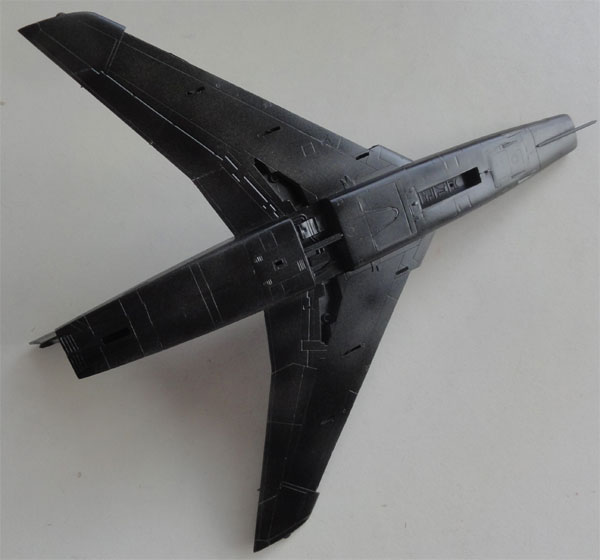
Now the trick... when dried, some
black areas with masked of with VERY LOW tack masking film from Revell.
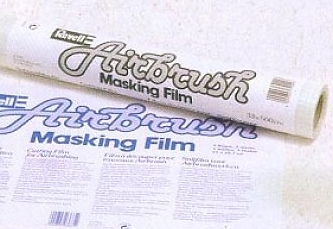
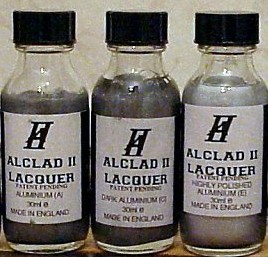
Next, a few thin layers with the
airbrush using ALCLAD II, in this case Gloss Aluminium ALC-105.
After 3 minutes, the masking films at the covered areas were removed with
a tweezer.
Immediately, now these panels were
lightly airbrushed with the same ALCLAD ALC-105 but not too thick. This
gives a DIFFERENT sheen and looks very good as on real bare metal aircraft.
So using this trick saves time a trouble as compared to adding a different
separate colour.
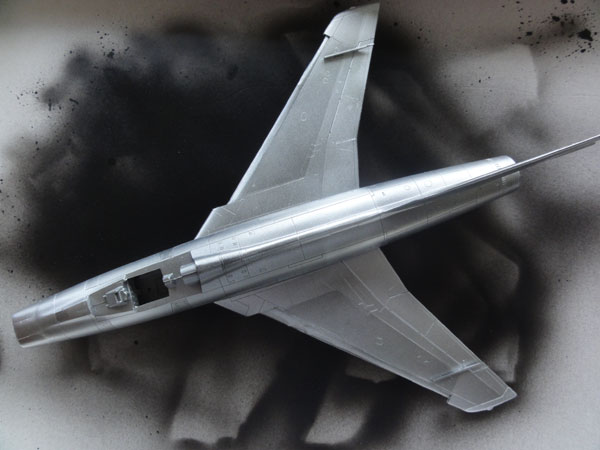
Real Super Sabres always showed burned
areas at the rear fuselage. At the rear of fuselage, the model got a few
strains of "clear transparant blue" using Tamiya acrylic X23 with the
airbrush.
 .
.
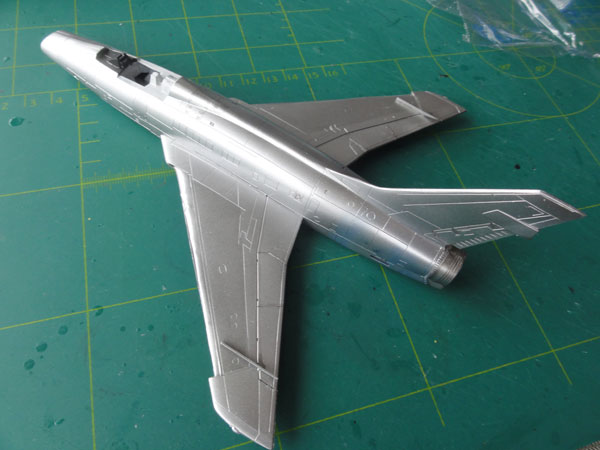
I opted for a Turkish F-100D
of the "Panther squadron" (111 filo 1.AJU Eskisehir) with a panther marking
on the nose and red-white trim. The red-white areas were masked and than
first a white coat airbrushed, followed after masking by the red (using
Revell Aqua 330 "fuer rot" red).
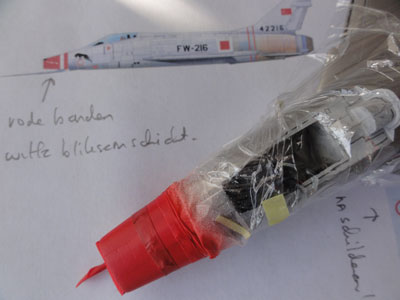 .
.
The model next got its decals as it had a gloss (metallic) undersurface.
This Turkish colour scheme has the "old style" squadred Turkish national markings. I thought I could use an old ESCI decal set with various national markings but these decals were very old, only I could use the Turkish Flag. But no problem, as the squared markings could be made from scrap using separate red and white decals; any brand can be used, I had wide XTRADECAL decal stripes. These were cut in squares at the correct size.
The "panther" was hand painted using
a drawing on clear decal with a paint brush, for both nose sides. The 2
decals were cut and applied as usual. This is much easier and less risky
than painting the panthers immediately directly onto the model.
 .
.
The other stencilling and smaller
markings came from the kit decals and an old Microscale set 72-97 for the
F-100: ...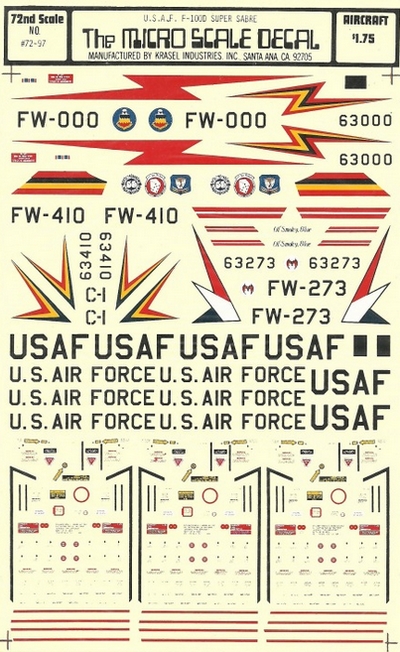 .
. .
.

Finishing is now done with the smaller parts. Fitting the rear horizontal stabilizers required enlarging a bit their slots. Wing tanks and gears were installed. The main gear legs have nice hydraulics moulded on but they are a bit thick so these were replaced with thin metal wire.
The canopy glass part #20c is one
piece. It also has a strange frame moulded at the rear, it should NOT be
there. So this was polished away with a nail polishing block and Tamiya
rubbing compound (or use any other stuff you have for polishing).
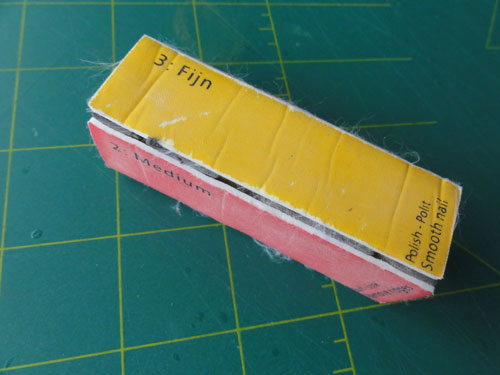
The canopy was installed closed and
smaller gaps closed with white glue. (if you want it opened up, separate
the windscreen with a razor saw, see also note above...).
In most cases, the Turkish F-100 flew
without refuelling probe, so these kit parts remained unused. Slats
were installed and anti-collision light painted red and blue dots on the
wing tips. A drop of Kristal Kleer was added on these small dots.
A nose pitot tube was installed made
from a metal needle, glued with super glue.
Finally, a very thin overall coat
of ALCLAD II ALC-105 was "misted" over some areas with the airbrush, this
"blends in" the decals and looks really good. That completed this model.

 .
.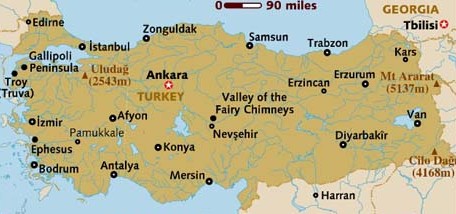
 ..Current:
..
..Current:
..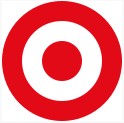 Old style before 1972:
Old style before 1972: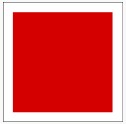
[area: 783,300 km2 | population: 83,6 million | capital: Ankara | GDP 7,500 USD nominal per capita ]
The Turkish
Air Force ("Türk Hava Kuvvetleri") was established in 1911 and during
the Balkan wars in 1912 and 1913 a few aircraft were used and flown by
mercenaries. During the first World War, Germany supplied aircraft. After
the Second World War, Turkey joined NATO and got various American aircraft
types. One of these was the F-100 Super Sabre and the Turk Hava Kuvvetleri
received 206 F-100C, D and F Super Sabres and most came from USAF stocks.
Also 21 F-100Ds and two F-100Fs were supplied second hand by Denmark. Turkish
F-100s saw extensive action during the 1974 military operation against
Cyprus. It was replaced by the F-4 Phantom in the late seventies and the
Turkish F-100 was out of service in 1982.
As of today,
the air force and army are one of the largest in NATO. Large numbers of
F-16 aircraft are used as well as types
like the F-4, F-5 and various transports
and helicopters. More recently there were severe disagreements with the
USA as Russian equipment was purchased and so F-35 deliveries never
took place.
This model now
represents a F-100D of the "Panther squadron" 111 filo 1.AJU Eskisehir
of "Türk Hava Kuvvetleri" in the early 1970s with the earlier white-red
squares.
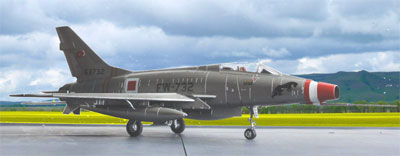 .
.
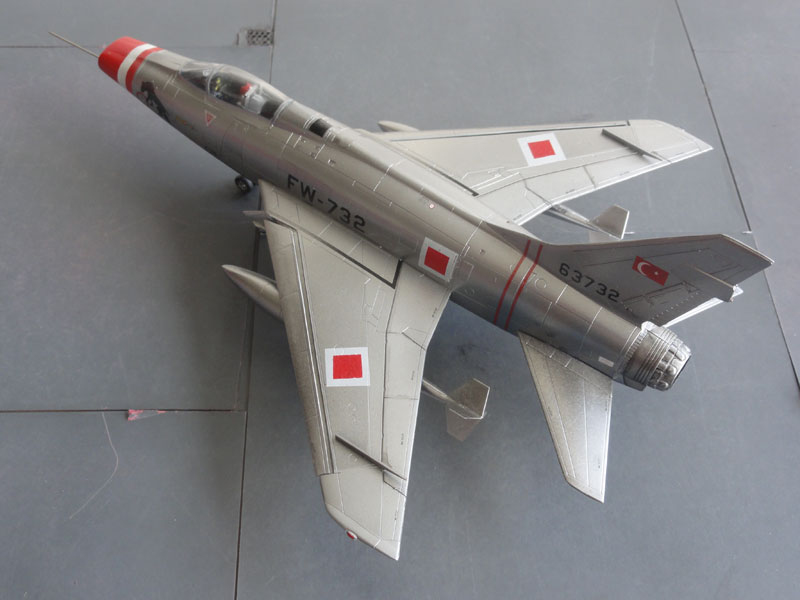 .
.
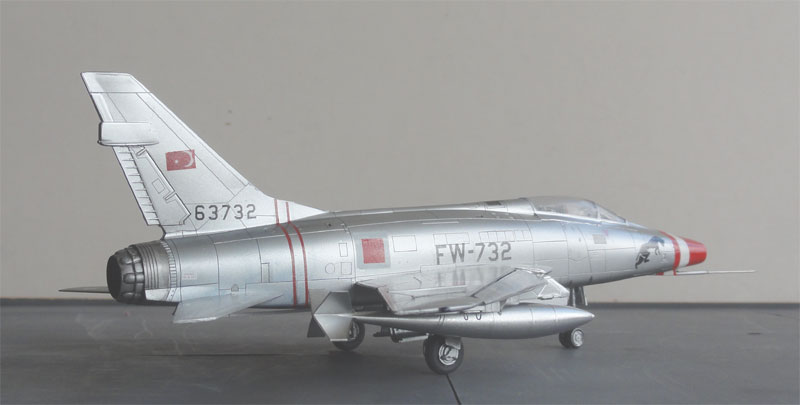
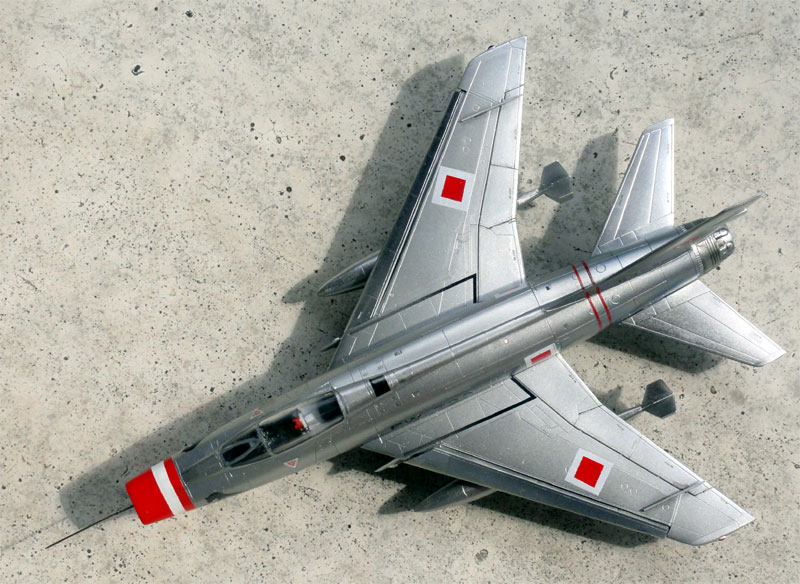 .
.
A nice Super Sabre model is now in the World Air Forces collection.
Back to 1/72 Models.......

(c) Copyright Meindert "designer"/ All rights reserved. Your comments are welcomed by webmaster
April 18, 2016
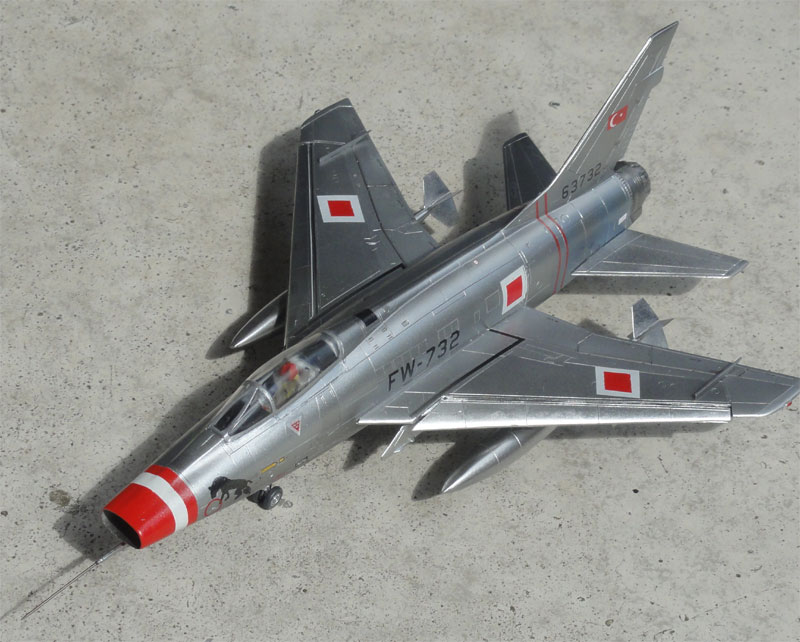 .
.
